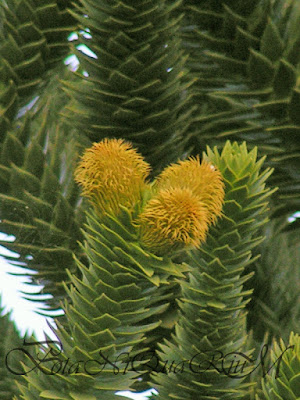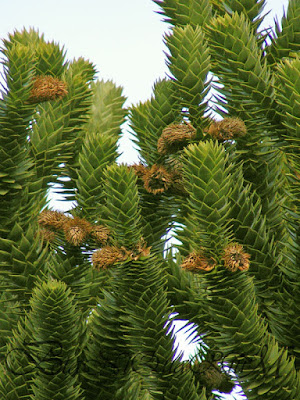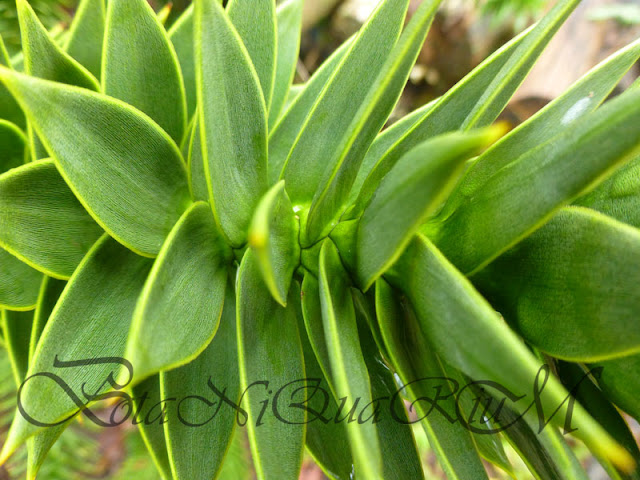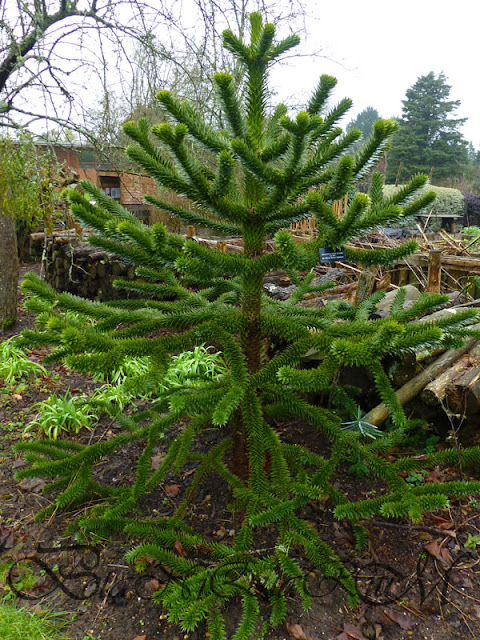 |
~ MONKEY PUZZLE ~A large conifer with long stout branches and spikey leaves. Highly architectural it is a real feature in any garden. Needs space. |
ARAUCARIA ARAUCANA
ARAUCARIACEAE
EN: Monkey Puzzle, D: Chilenische Araukarie, FR: Araucaria du Chili, ESP: Araucaria o pehuén, ZH: 智利南洋杉
EN: Monkey Puzzle, D: Chilenische Araukarie, FR: Araucaria du Chili, ESP: Araucaria o pehuén, ZH: 智利南洋杉
Description:
Evergreen, stout conifer with a remarkable symmetrical habit, strongly architectural, pyramid-shaped, long-lived and very slow-growing, usually appears to be dioecious although sometimes both sexes are found on the same tree, branches borne in whorles down to ground level, unless planted in industrial areas where it soon looses its lower branches and will look tattered overall, branches appear long and spidery growing in almost 90degree angles from the main stem, later drooping, covered in overlapping, rigid and leathery leaves, each tipped with a spine which makes any work with or near the tree awkward, green flowers appear during summer, male flowers are oval-shaped and erect, up to 15cm long whereas female cones are spherical, usually around 18cm long, pollinated by wind, the cones take about three years to mature, seeds are edible although taste better when roasted, average 1000 seed weight (TKG) = 4235g, seeds are dispersed by animals, Araucaria araucana is a valuable timber tree, but logging of wild trees is now strictly prohibited.
Araucaria araucana was discovered by a Spanish explorer in about 1780. 15 years later Archibald Menzies introduced it to the English garden culture in 1795.
Height: eventually a large tree of 50m (165ft), however will take at least a century to reach this height
 |
 |
| Emerging inflorescence on Araucaria araucana | Last years male flowers on Araucaria araucana |
 |
| Each branch ends in a leaf bud. |
Maintenance:
Newly planted trees should be staked for a couple of years to avoid wind rock. After establishing remove stake. Remove weeds and grass around young specimen at all times until they are at least 1,5m tall as they are very slow-growing and suffer in that competition. Otherwise no maintenance required. Keep root disturbance to a minimum. As with most conifers if terminal bud is pruned/removed the plant responds with unshapely bushy growth.
Propagation:
Usually by seeds, seedlings will take many years until big enough to be planted out. Decent sized specimen of at least 60cm height are very costly due to their slow growth and conservation status. Cuttings can be taken from terminal buds, which will leave the specimen unshapely and most likely ruined.
Meaning of plant name:
ARAUCARIA: from a tribal area of Chilean Indians, Southern Chile, Andes, from the Araucanos, a group of Amerindian tribes
ARAUCANA: from a tribal area of Chilean Indians, Southern Chile, Andes, from the Araucanos, a group of Amerindian tribes
Origin:
Chile and Argentina where it grows at 600 to 1,800 m above sea level in moist areas rich with volcanic ash, in mixed deciduous and evergreen forests or in pure stands.
 |
| Terminal buds on Araucaria araucana |
Growing conditions:
Prefers well-drained yet moist, rich soils, on any pH, alkaline or acid soils, on loam, sand or chalk, thrives in full sun, tolerates partial shade , however will grow even slower then, will not like polluted locations, once established able to withstand strong winds.
Hardiness: H7 - Hardy in the severest European continental climates (below -20°C)
Pests and Diseases: generally no problems
Other useful information:
Conservation status of Araucaria araucana: Vulnerable (VU) according to IUCN Red List criteria. Despite being officially declared a Natural Monument in 1990 (making it an offence to cut down wild trees), forests outside of protected areas are still subject to high levels of damage due to burning, grazing and conversion to commercial plantations.
Araucaria araucana is also listed in CITES (the Convention on International Trade in Endangered Species of Wild Fauna and Flora) Appendix 1, which includes species threatened with extinction. Trade in specimens of these species is permitted only in exceptional circumstances.
 |
| Araucaria araucana bark detail |
 |
| Spikey branch structure on A. araucana |
 |
| Overlapping leaves cover the branches, appearing like scaley reptiles. |
 |
| A young specimen of Araucaria araucana |
 |
| Each leaf has a sharp point making it a painful job to handle. |
 |
| Araucaria araucana |
Have a look at Related Species
